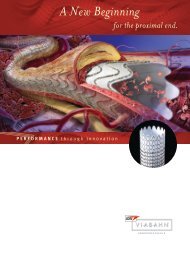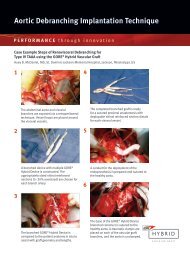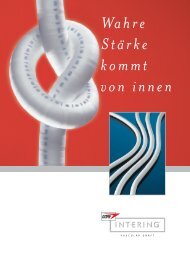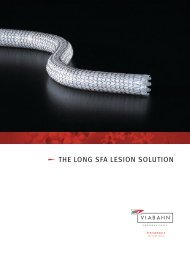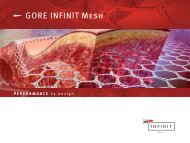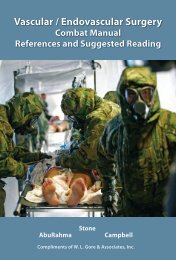Instructions for Use - Multilingual - Gore Medical
Instructions for Use - Multilingual - Gore Medical
Instructions for Use - Multilingual - Gore Medical
You also want an ePaper? Increase the reach of your titles
YUMPU automatically turns print PDFs into web optimized ePapers that Google loves.
• Cardiac arrest• Renal failure• Sepsis• Significant pleural or pericardial effusion requiring drainage• Significant bleeding• Endocarditis• Headache or migraine• TIA or stroke• DeathHOW SUPPLIEDThe GORE® Septal Occluder is supplied sterile in a protective tray and pouch.Provided that the integrity of the pouch is not compromised in any way, it willserve as an effective barrier until the “use by” (expiration) date printed onthe box.REQUIRED ACCESSORIES• 10 Fr Introducer Sheath• Heparinized saline• Flushing syringe• Stopcock• Sizing balloon• Sterile bowl <strong>for</strong> flushing catheterOPTIONAL ACCESSORIESGuidewire with diameter of 0.035" / 0.89 mm (if necessary <strong>for</strong> defect access)12 Fr Introducer Sheath when a guidewire is utilized.RECOMMENDED PROCEDURESA. Sizing the Defect and Selecting the Proper Occluder Size1. <strong>Use</strong> echocardiography to measure the septal length.2. Measure the septal defect using fluoroscopy or echocardiography; the stopflow balloon technique is recommended, as described below:a. Place a contrast filled, compliant balloon across the defect and gentlyinflate until shunting through the defect has stopped.b. Measure the diameter of the defect using either echocardiography orcalibrated fluoroscopy.3. Select the appropriate occluder size <strong>for</strong> the defect, taking the followingrecommendations into consideration:• The occluder size selected <strong>for</strong> the defect is recommended to be atleast a 2:1 ratio. An occluder that pulls through the defect after disccon<strong>for</strong>mation may be too small and should be removed and replacedwith a larger size.• There must be adequate space to accommodate the discs withinthe atrial chambers. To assure that there is adequate space toaccommodate the discs within the atrial chambers, the selectedoccluder diameter should be less than 90% of the measured septallength.• The septal tissue margins surrounding the defect must be ofsufficient size and integrity to prevent disc prolapse through thedefect and Occluder embolization.B. Access Site Preparation1. Prepare the venous access site according to standard practice.2. Place appropriately sized Introducer Sheath.C. Occluder Preparation and Loading1. Check the “use by” (expiration date) and the condition of the package.2. Using aseptic technique, remove the sterile tray from the pouch, andremove the packaging tray lid.3. Remove the device from the package and visually inspect the device <strong>for</strong>shipping damage.4. Remove the packaging insert from the handle (Figure 3).5. Loading and Flushing the Occluder:a. Submerge the Occluder and catheter tip in a heparinized saline bathduring loading to reduce the chance of air entrapment in the deliverysystem.b. Fill a syringe with heparinized saline.c. Attach the syringe to a stopcock and the Flushing Port.d. Flush the device until air no longer exits the tip of the DeliveryCatheter.e. When the initial flushing is completed, begin loading the Occluder bypushing the gray Loading and Deployment Slider up and then to theright until the gray Loading and Deployment Slider stops (Figure 4a).f. Complete Occluder loading by pushing the gray Loading andDeployment Slider down and then to the right until it stops(Figure 4b).g. Flush the device again until air no longer exits the tip of the DeliveryCatheter.h. If additional air removal is desired, it is recommended to deploy theOccluder (refer to Section E "Occluder Deployment") and repeat stepsd - g above.The Occluder Lock Mechanism should not be moved be<strong>for</strong>e or duringOccluder loading or deployment. Partial or complete Occluder locking mayprevent Occluder loading and deployment.FIGURE 3: Package Insert Removal3




